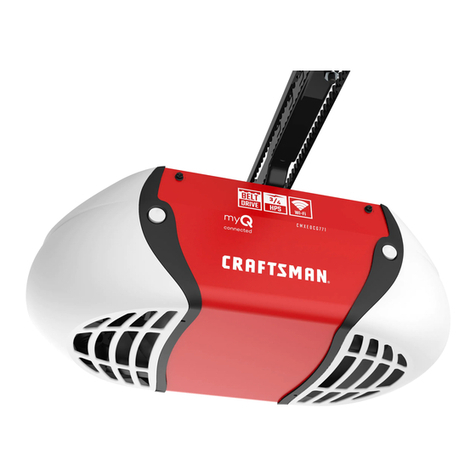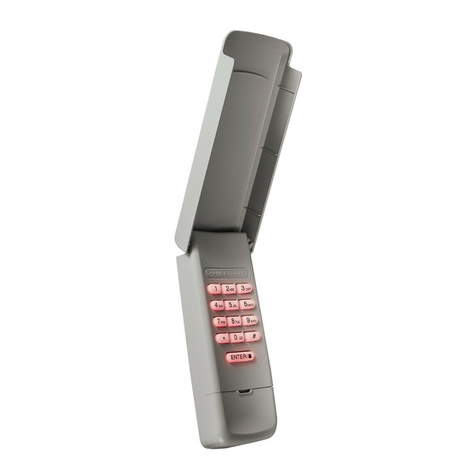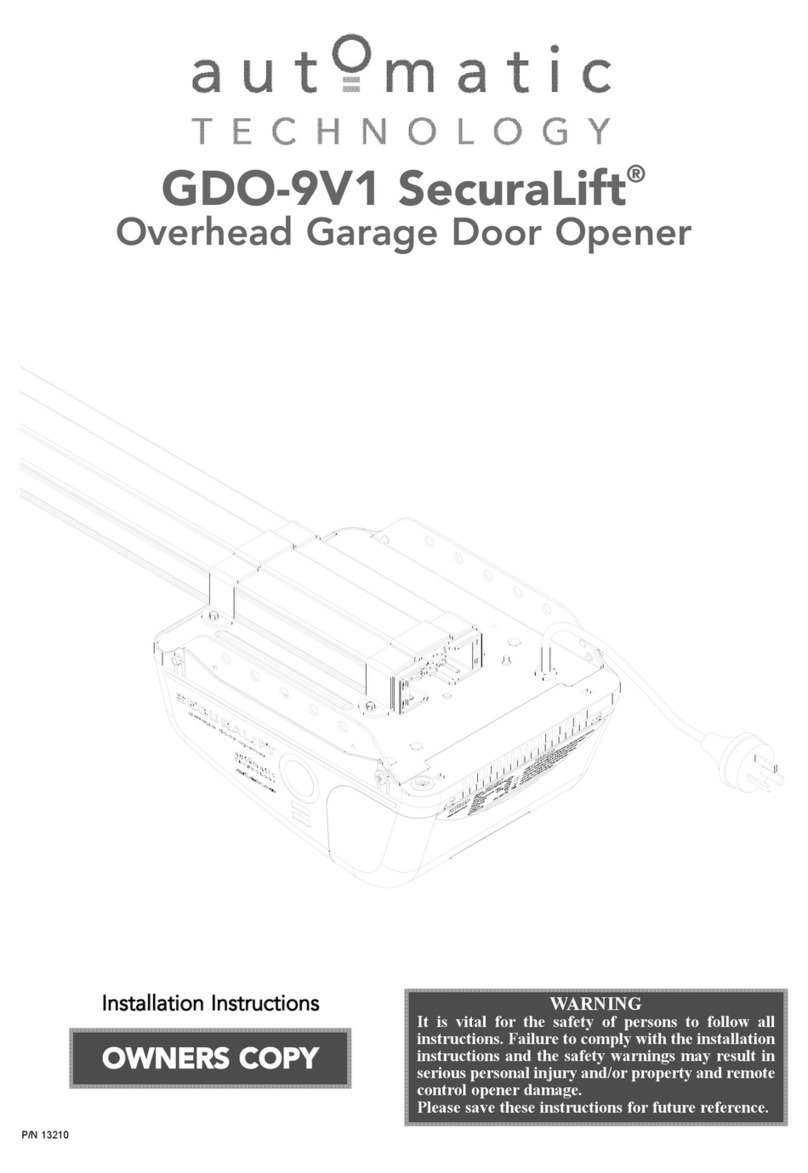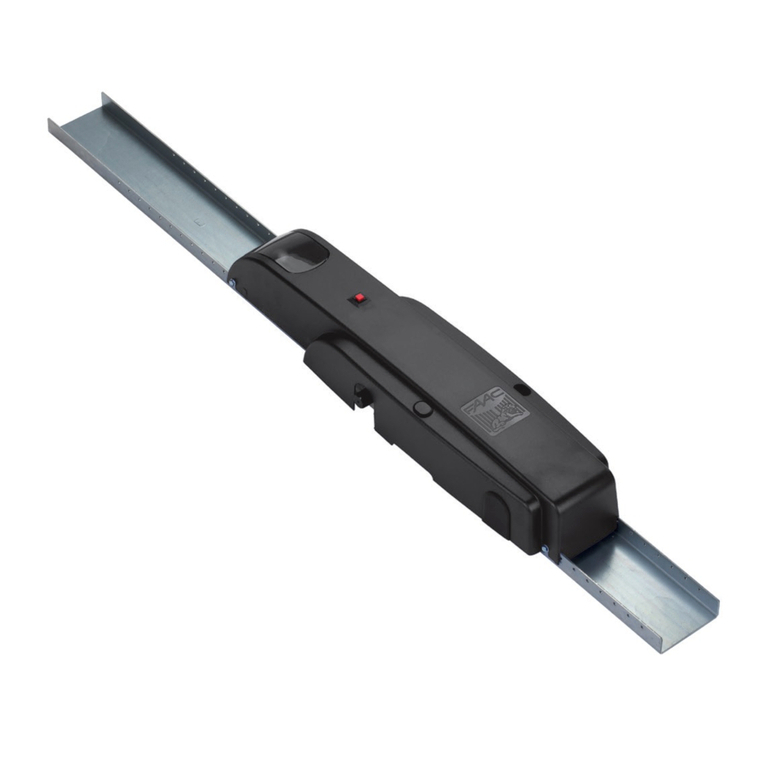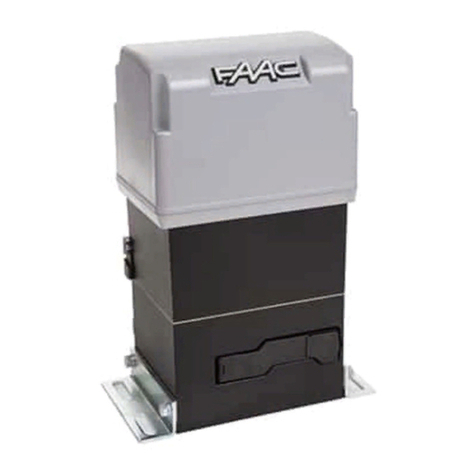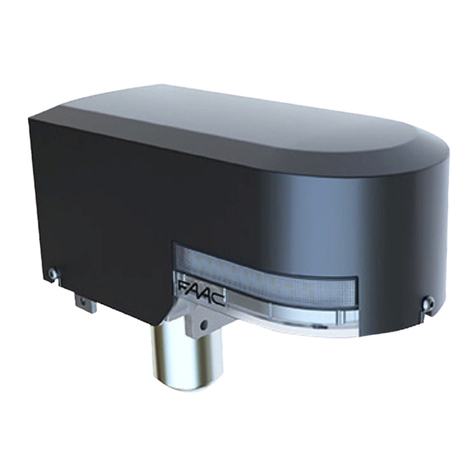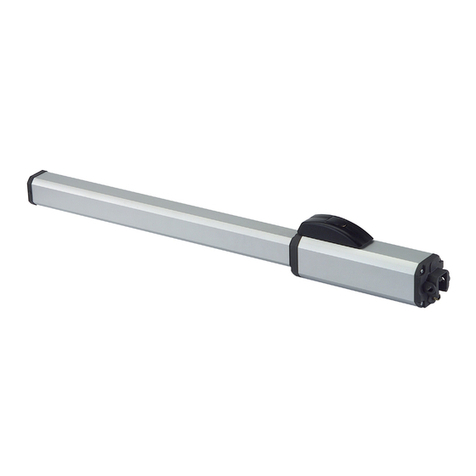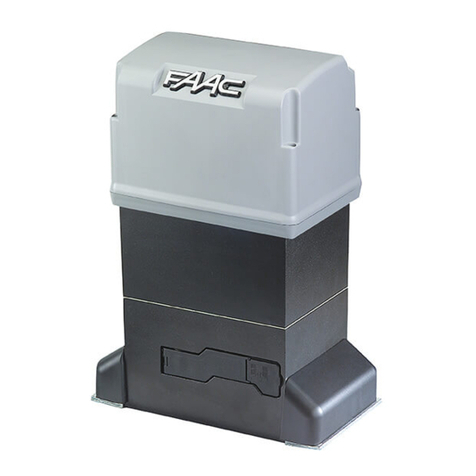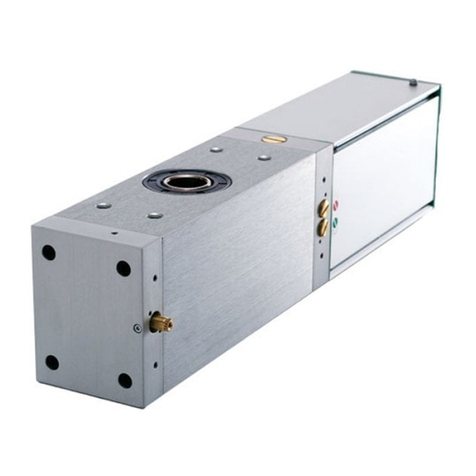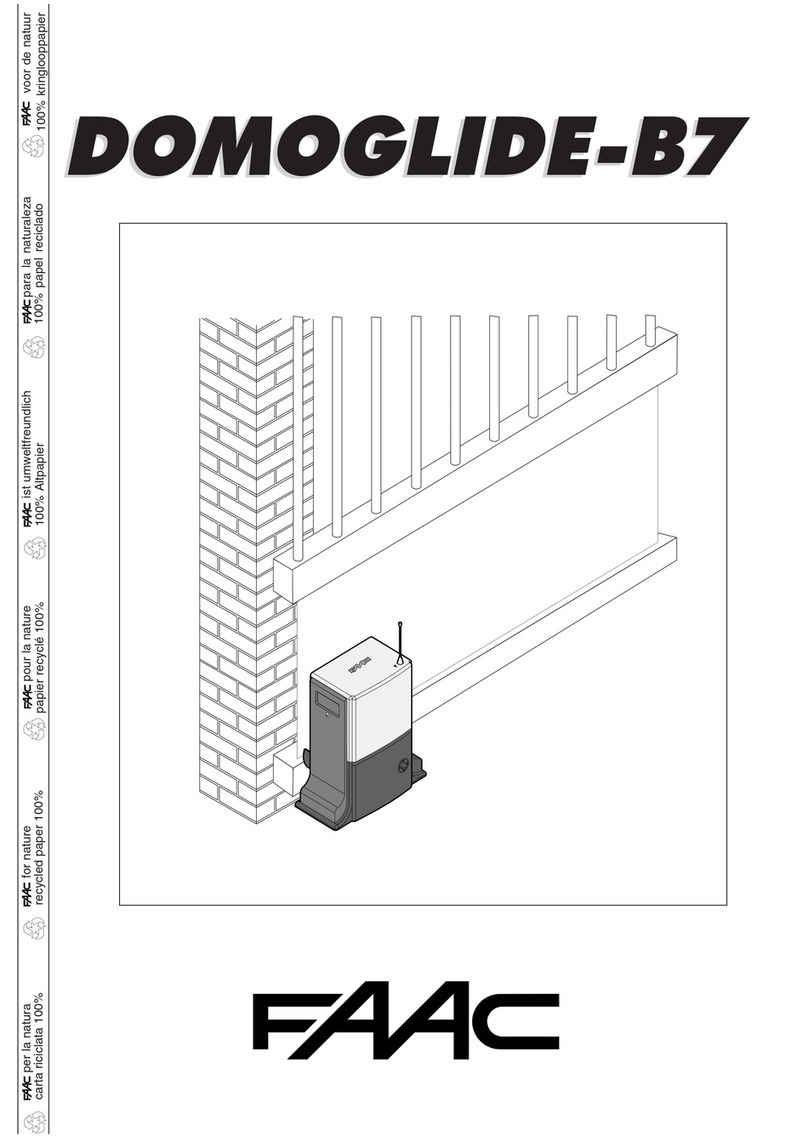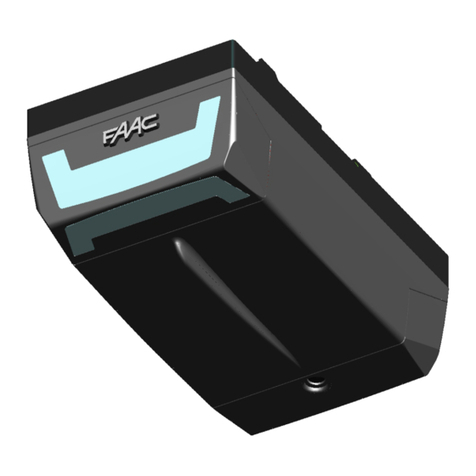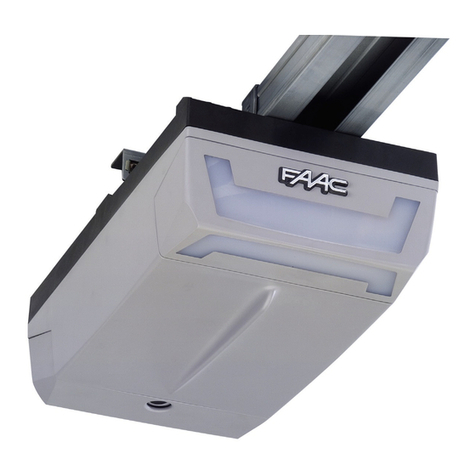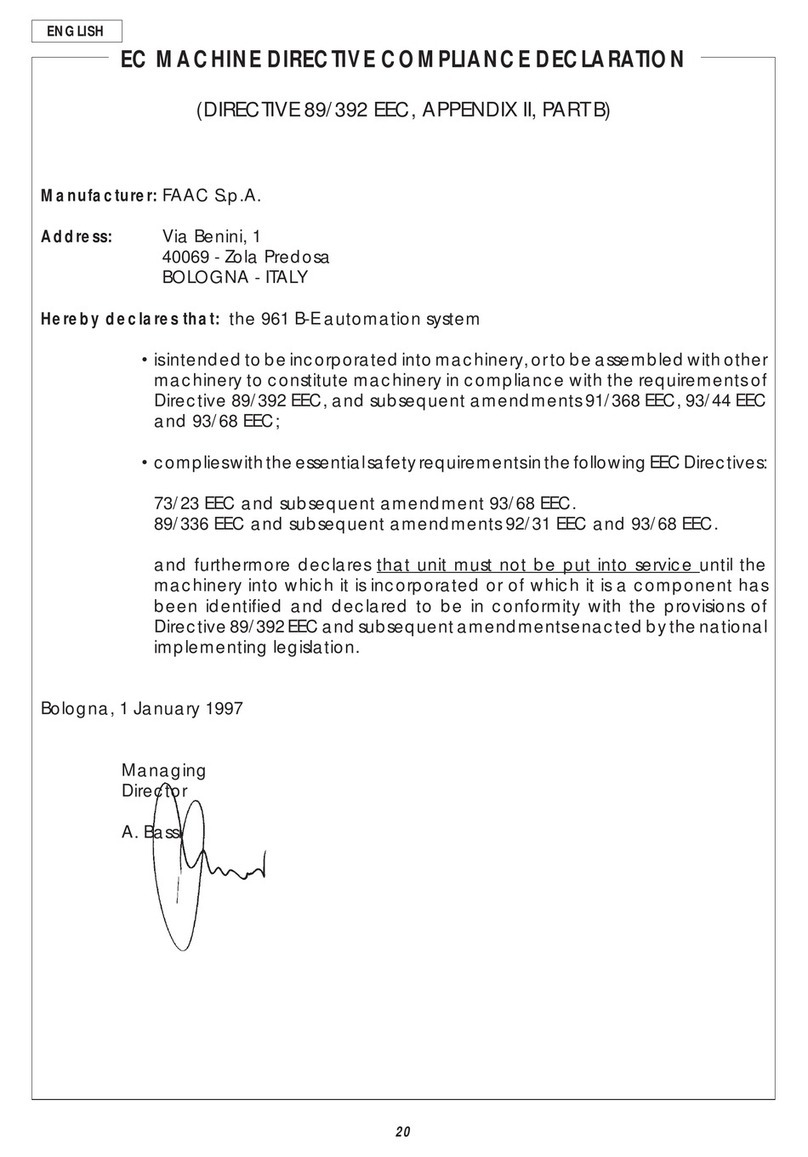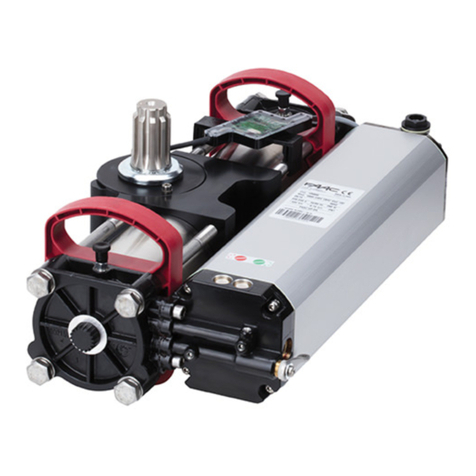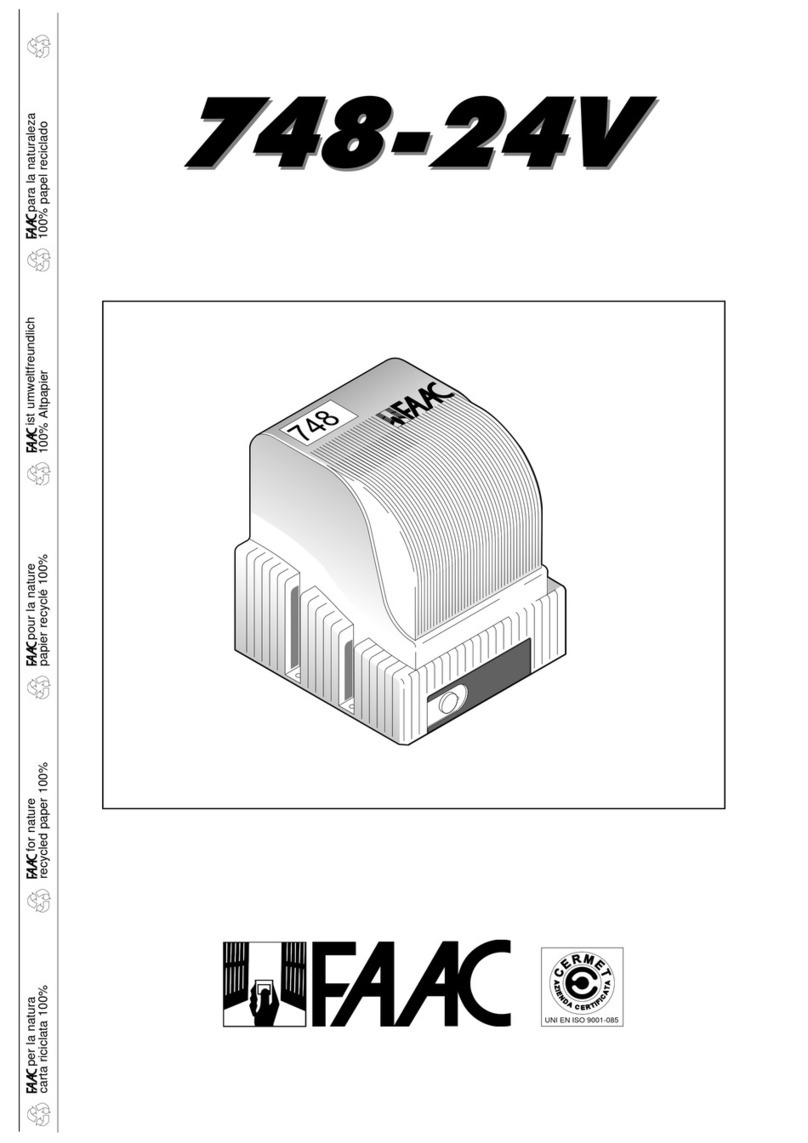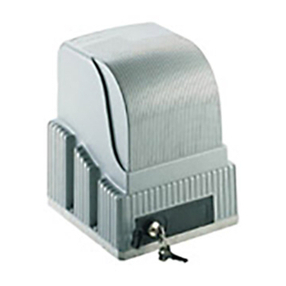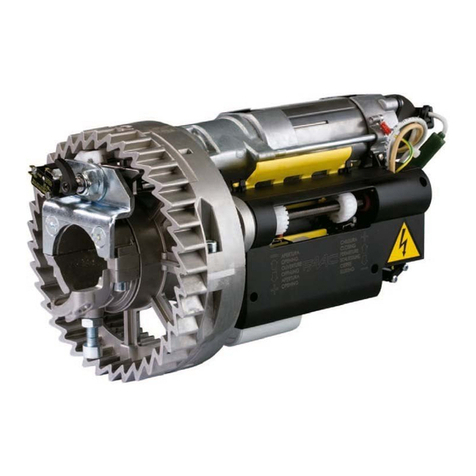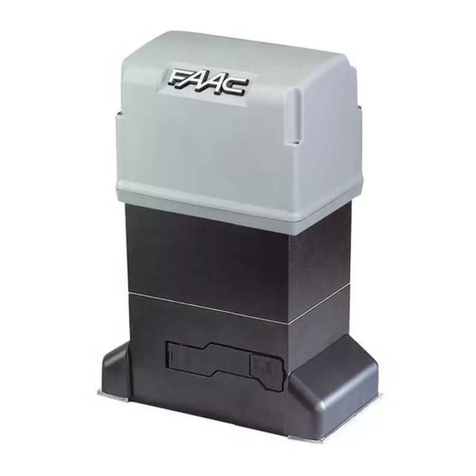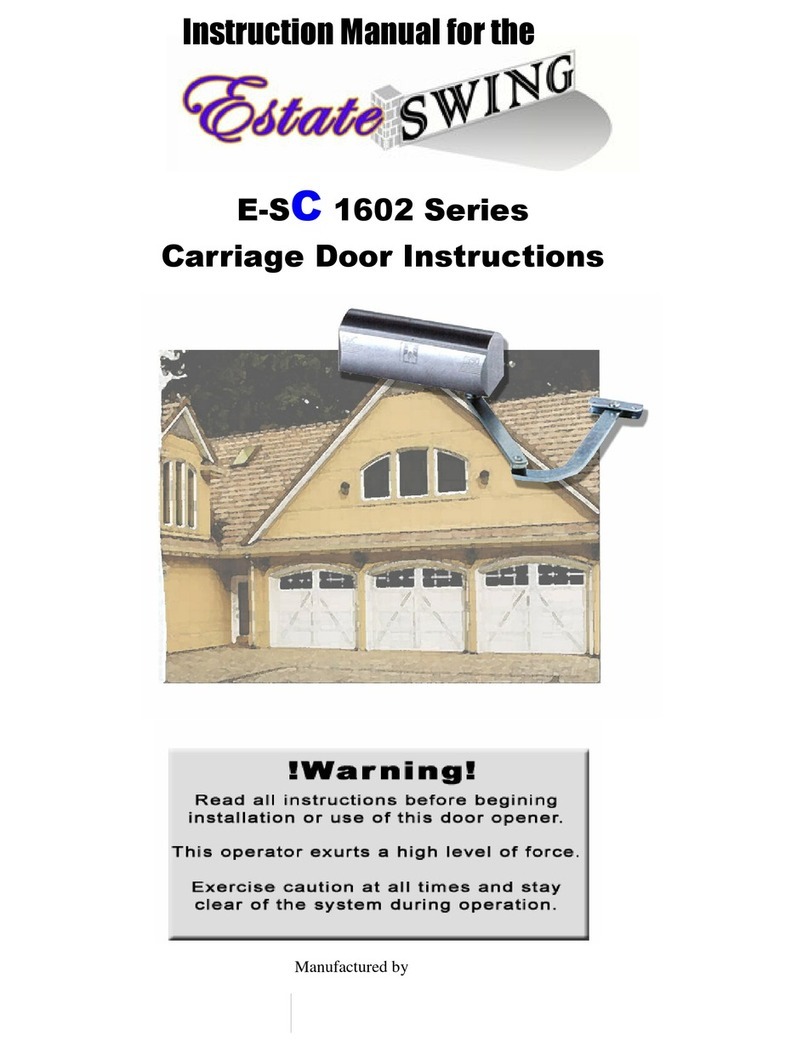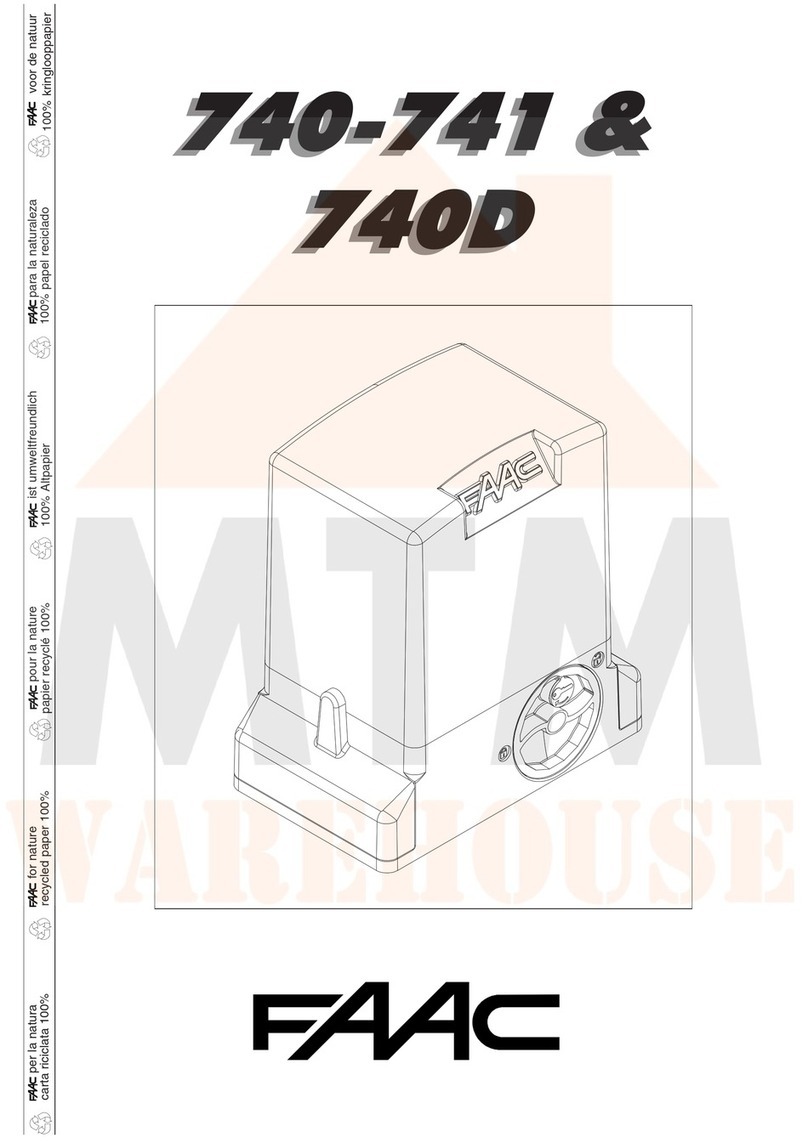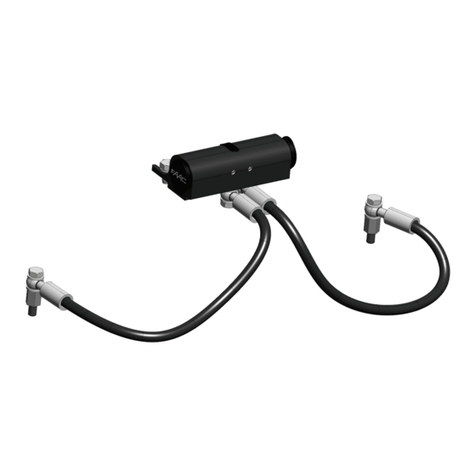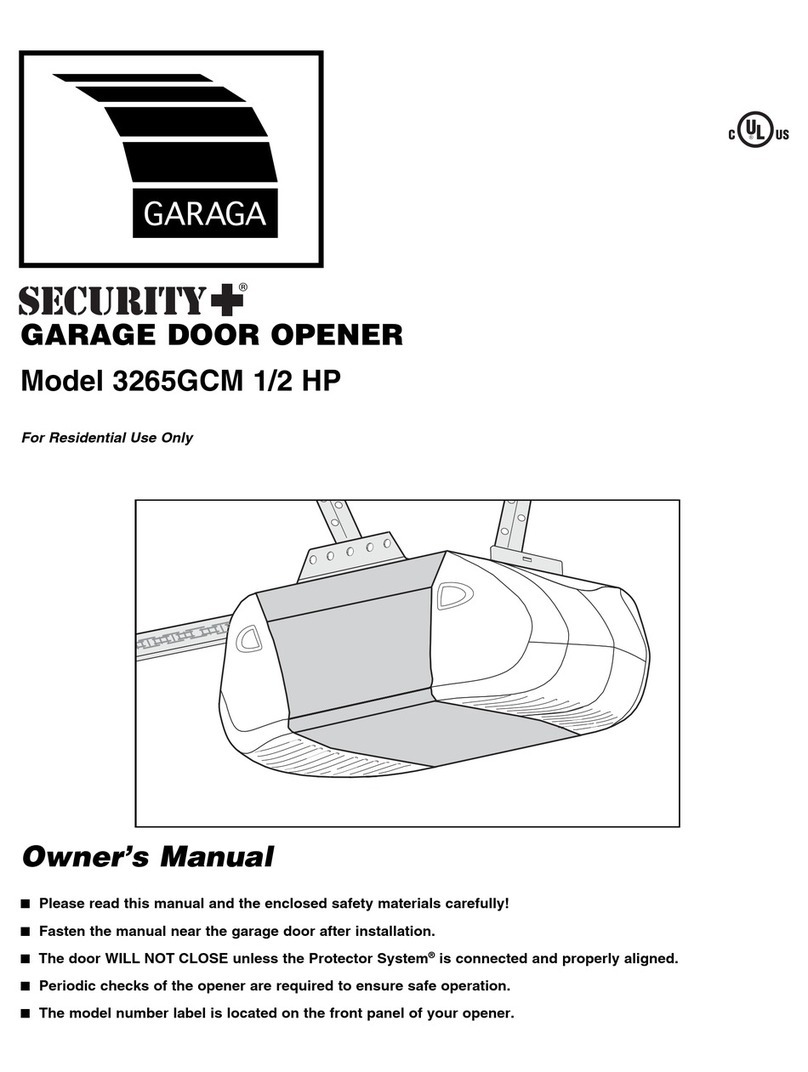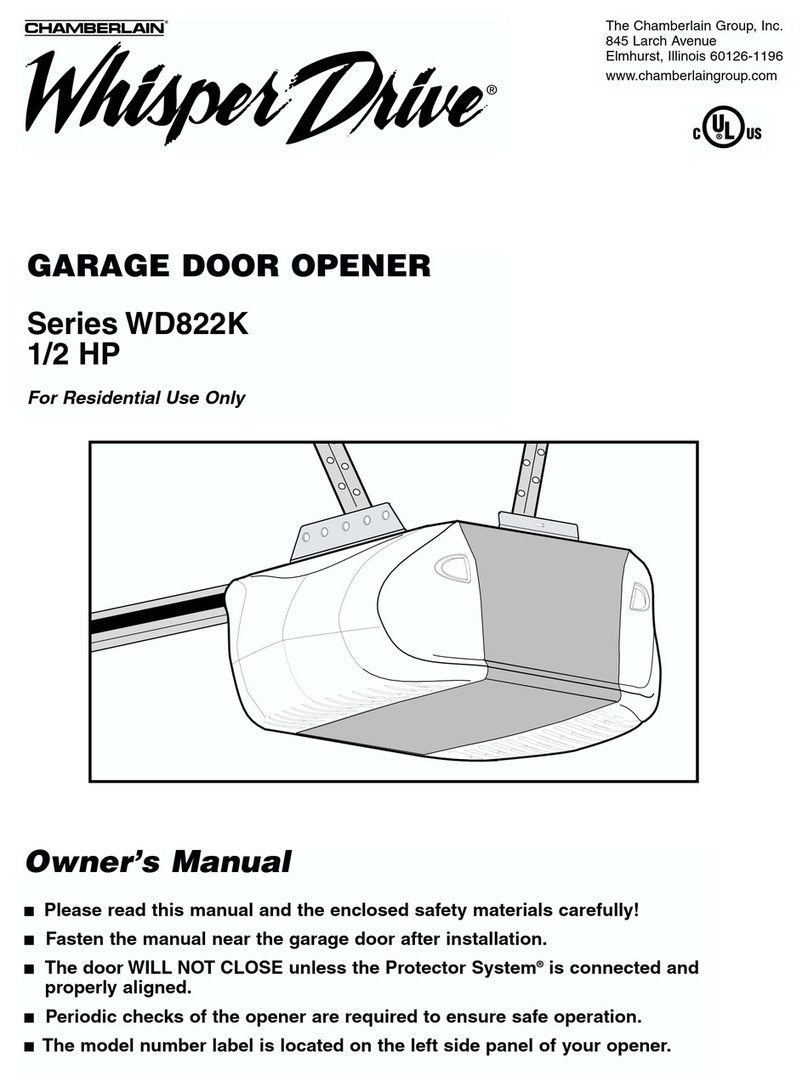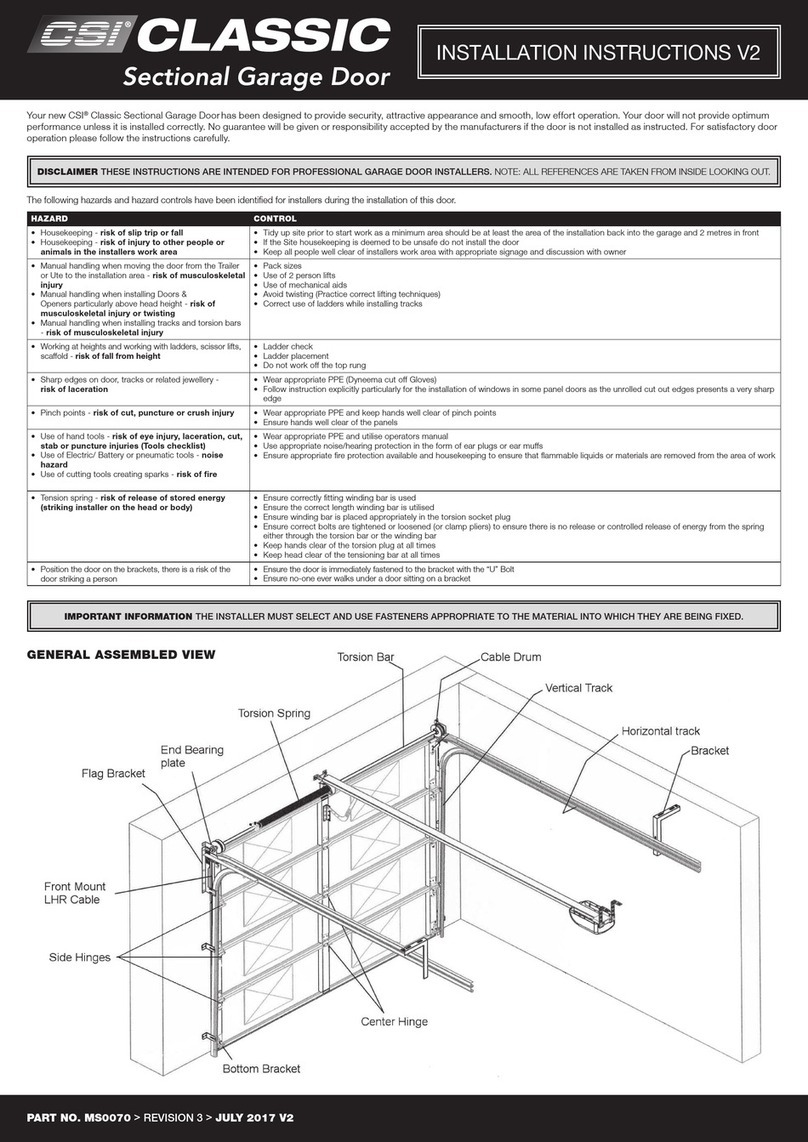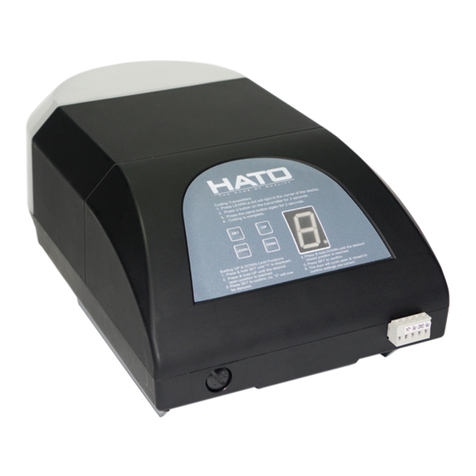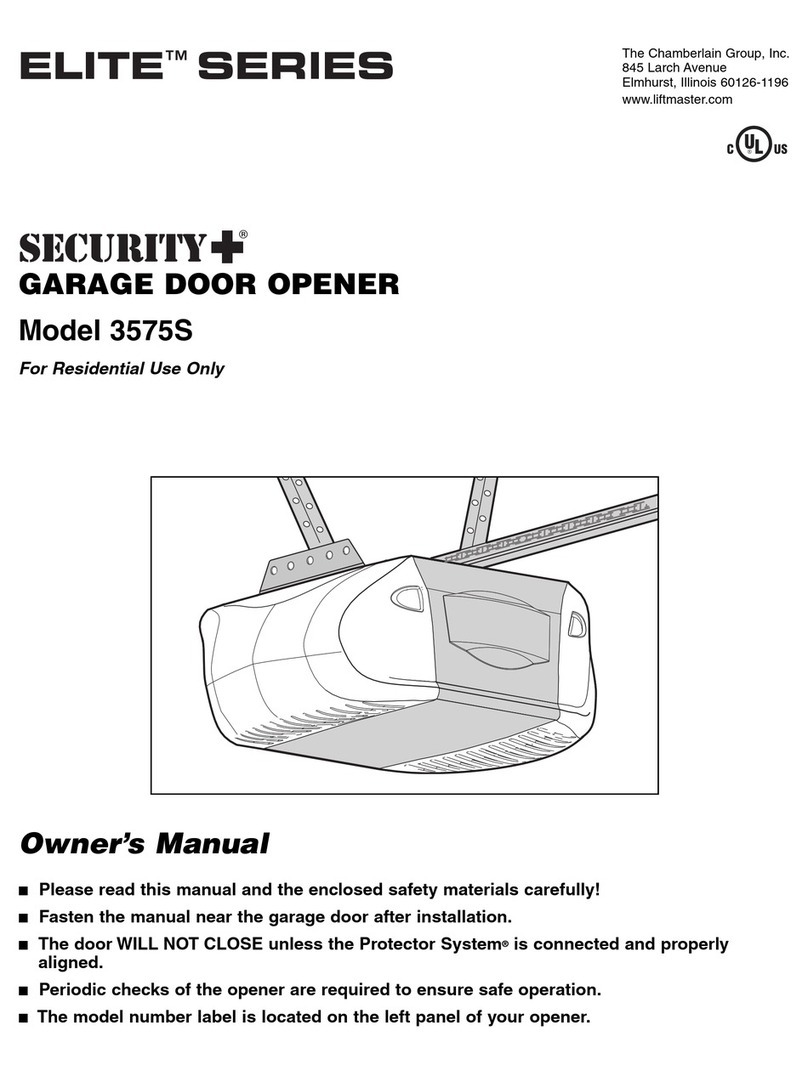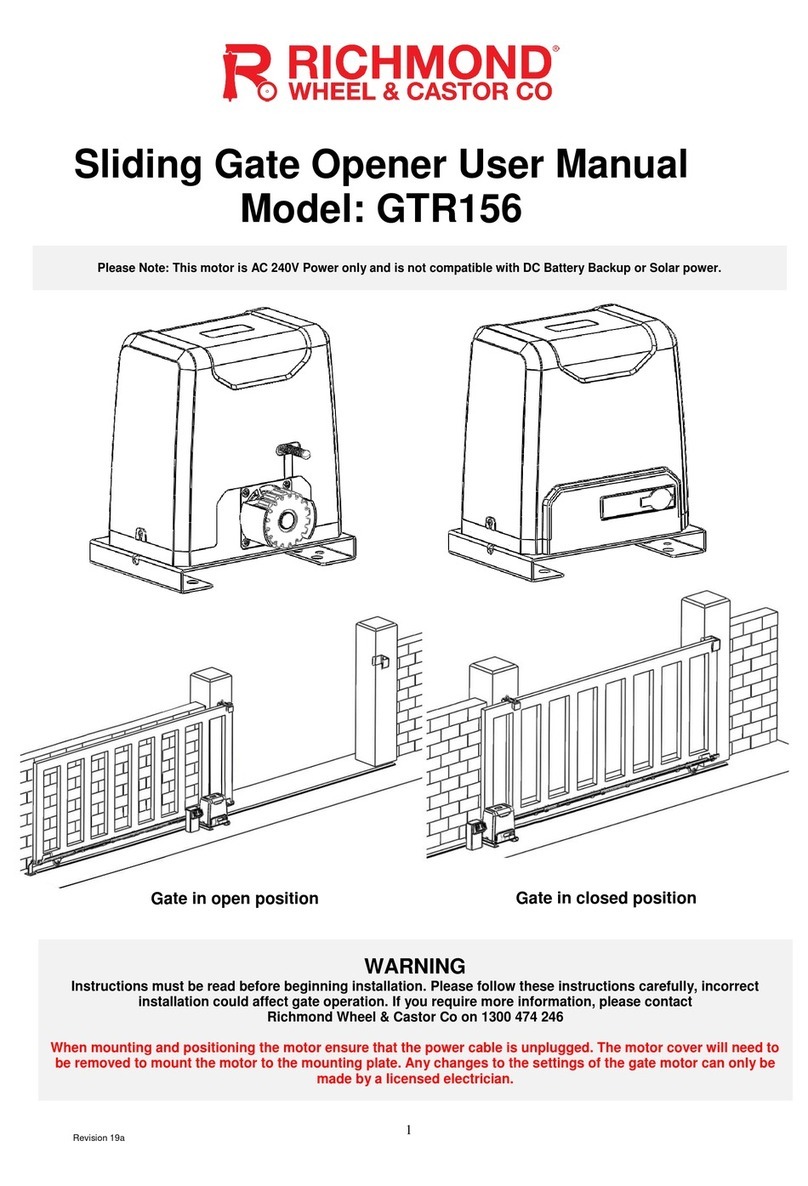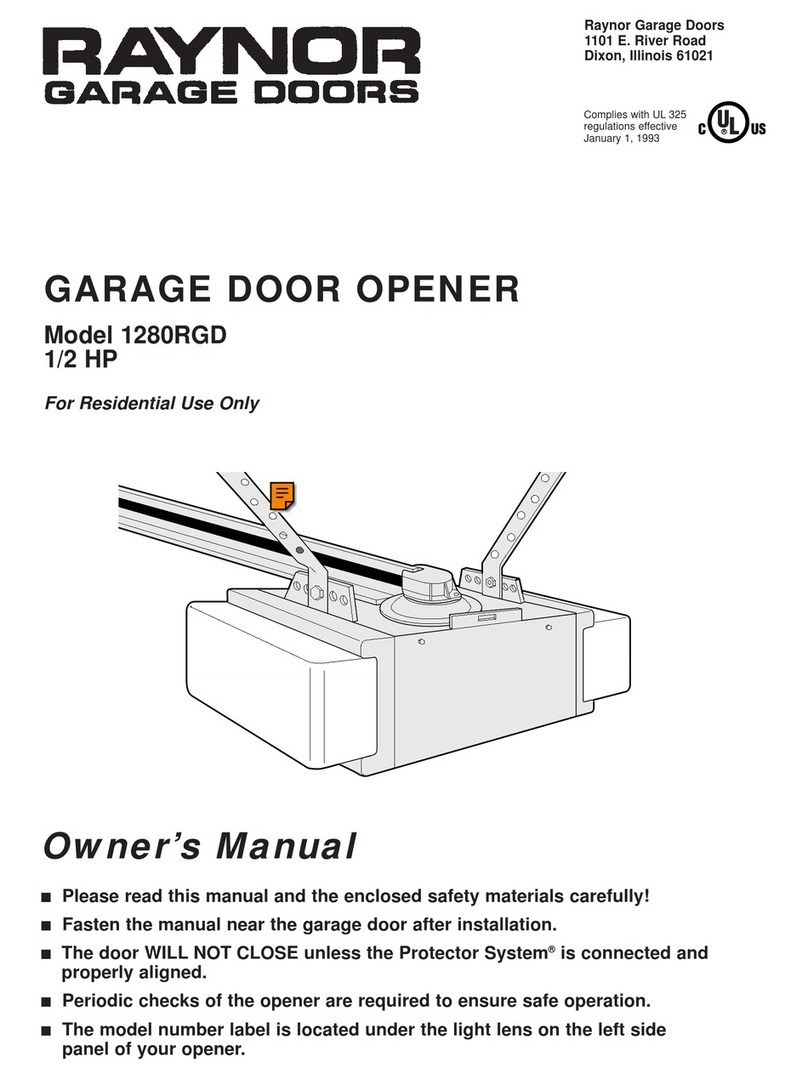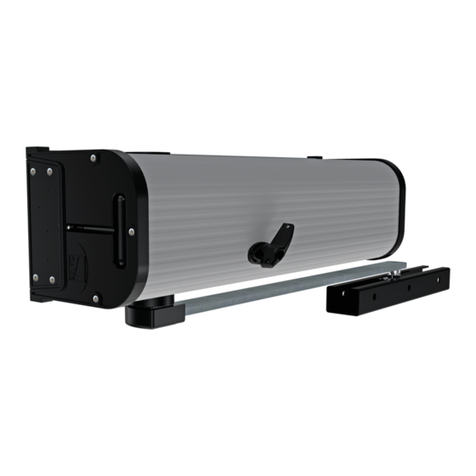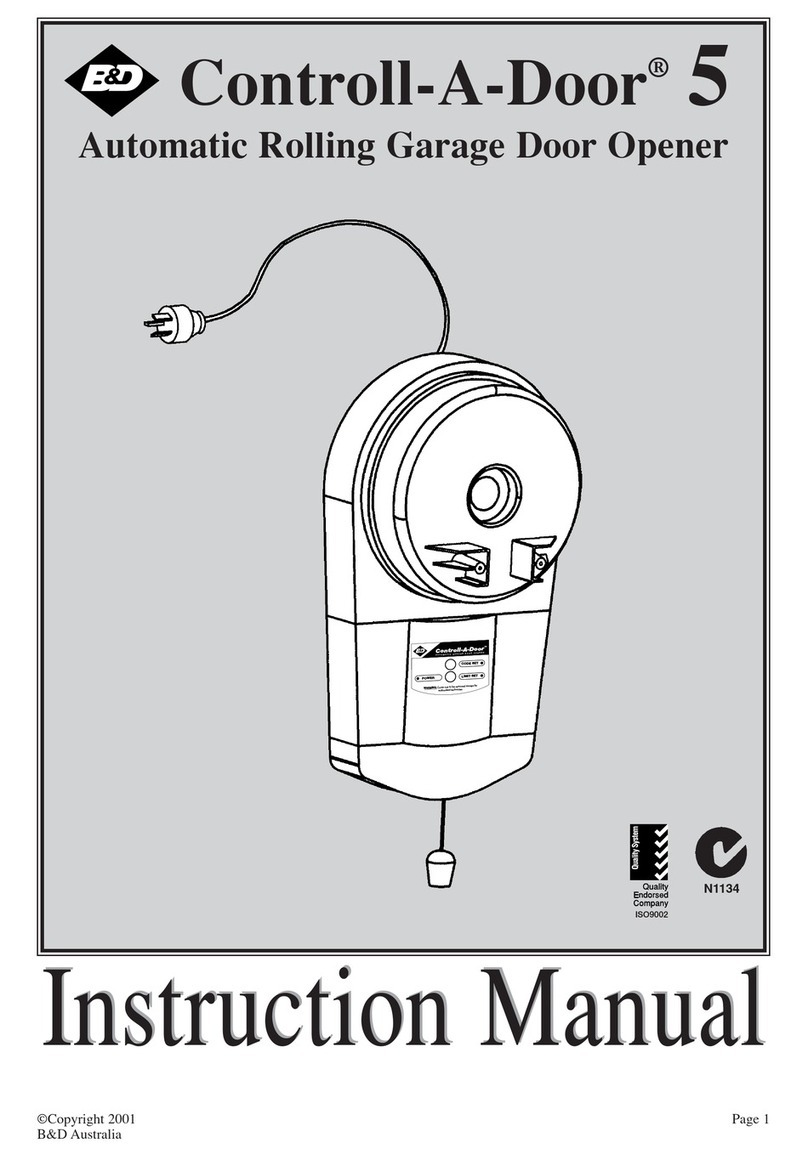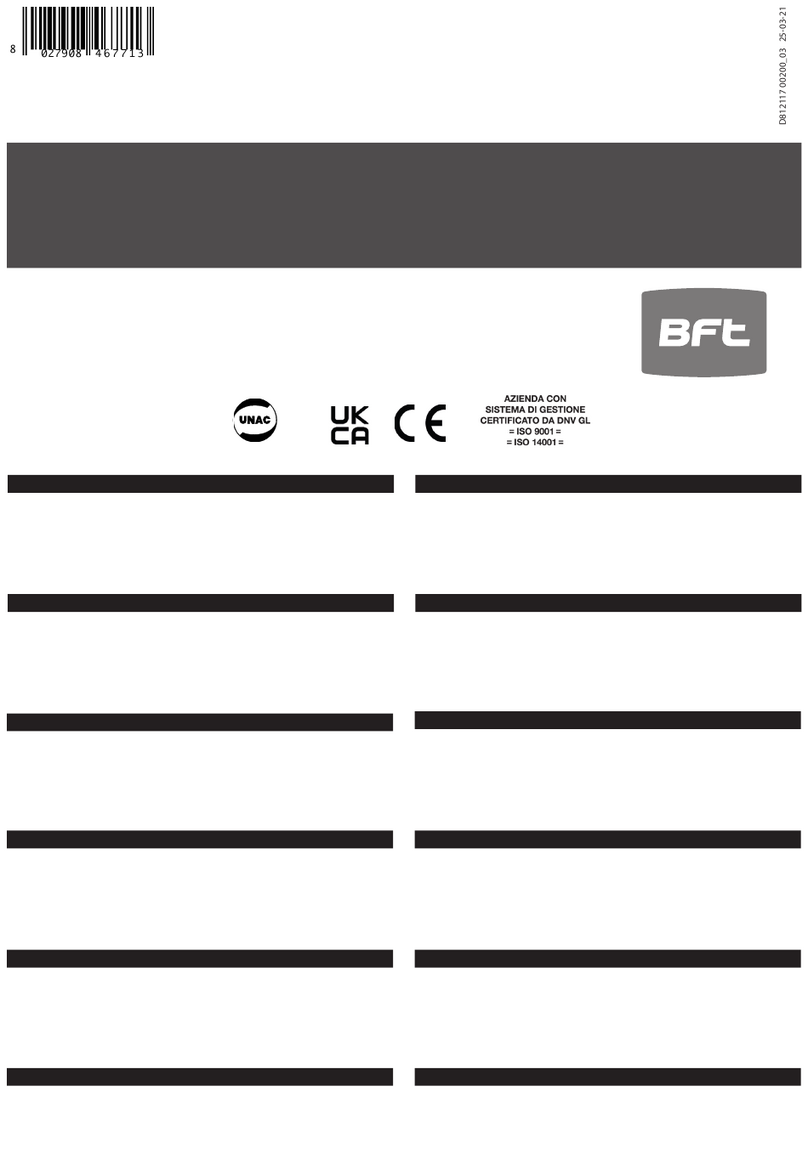
de los niños, ya que constituyen fuentes potenciales de peligro.
Guarden las instrucciones para futuras consultas.
Este producto ha sido proyectado y fabricado exclusivamente para la utilización
indicada en el presente manual. Cualquier uso diverso del previsto podría perjudicar
el funcionamiento del producto y/o representar fuente de peligro.
FAAC declina cualquier responsabilidad derivada de un uso impropio o diverso del
previsto.
No instalen el aparato en atmósfera explosiva: la presencia de gas o humos inflama-
bles constituye un grave peligro para la seguridad.
Los elementos constructivos mecánicos deben estar de acuerdo con lo establecido
en las Normas EN 12604 y EN 12605.
Para los países no pertenecientes a la CEE, además de las referencias normativas
nacionales, para obtener un nivel de seguridad adecuado, deben seguirse las
Normas arriba indicadas.
FAAC no es responsable del incumplimiento de las buenas técnicas de fabricación
de los cierres que se han de motorizar, así como de las deformaciones que pudieran
intervenir en la utilización.
La instalación debe ser realizada de conformidad con las Normas EN 12453 y EN
12445. El nivel de seguridad de la automación debe ser C+D.
Quiten la alimentación eléctrica y desconecten las baterías antes de efectuar cual-
quier intervención en la instalación.
Coloquen en la red de alimentación de la automación un interruptor omnipolar con
distancia de apertura de los contactos igual o superior a 3 mm. Se aconseja usar un
magnetotérmico de 6A con interrupción omnipolar.
Comprueben que la instalación disponga línea arriba de un interruptor diferencial
con umbral de 0,03 A.
Verifiquen que la instalación de tierra esté correctamente realizada y conecten las
partes metálicas del cierre.
La automación dispone de un dispositivo de seguridad antiaplastamiento consti-
tuido por un control de par. No obstante, es necesario comprobar el umbral de
intervención según lo previsto en las Normas indicadas en el punto 10.
Los dispositivos de seguridad (norma EN 12978) permiten proteger posibles áreas de
peligro de Riesgos mecánicos de movimiento, como por ej. aplastamiento, arrastre,
corte.
Para cada equipo se aconseja usar por lo menos una señalización luminosa así
como un cartel de señalización adecuadamente fijado a la estructura del bastidor,
además de los dispositivos indicados en el “16”.
FAAC declina toda responsabilidad relativa a la seguridad y al buen funcionamien-
to de la automación si se utilizan componentes de la instalación que no sean de
producción FAAC.
Para el mantenimiento utilicen exclusivamente piezas originales FAAC
No efectúen ninguna modificación en los componentes que forman parte del
sistema de automación.
El instalador debe proporcionar todas las informaciones relativas al funcionamiento
del sistema en caso de emergencia y entregar al usuario del equipo el manual de
advertencias que se adjunta al producto.
No permitan que niños o personas se detengan en proximidad del producto durante
su funcionamiento.
La aplicación no puede ser utilizada por niños, personas con reducida capacidad
física, mental, sensorial o personas sin experiencia o la necesaria formación.
Mantengan lejos del alcance los niños los telemandos o cualquier otro emisor de
impulso, para evitar que la automación pueda ser accionada involuntariamente.
Sólo puede transitarse entre las hojas si la cancela está completamente abierta.
El usuario debe abstenerse de intentar reparar o de intervenir directamente, y debe
dirigirse exclusivamente a personal cualificado FAAC o a centros de asistencia
FAAC.
Todo lo que no esté previsto expresamente en las presentes instrucciones debe
entenderse como no permitido
DEUTSCH
HINWEISE FÜR DEN INSTALLATIONSTECHNIKER
ALLGEMEINE SICHERHEITSVORSCHRIFTEN
ACHTUNG! Um die Sicherheit von Personen zu gewährleisten, sollte
die Anleitung aufmerksam befolgt werden. Eine falsche Installa-
tion oder ein fehlerhafter Betrieb des Produktes können zu schwe-
rwiegenden Personenschäden führen.
Bevor mit der Installation des Produktes begonnen wird, sollten die Anleitungen
aufmerksam gelesen werden.
Das Verpackungsmaterial (Kunststoff, Styropor, usw.) sollte nicht in Reichweite von
Kindern aufbewahrt werden, da es eine potentielle Gefahrenquelle darstellt.
Die Anleitung sollte aufbewahrt werden, um auch in Zukunft Bezug auf sie nehmen
zu können.
Dieses Produkt wurde ausschließlich für den in diesen Unterlagen angegebenen Ge-
brauch entwickelt und hergestellt. Jeder andere Gebrauch, der nicht ausdrücklich
angegeben ist, könnte die Unversehrtheit des Produktes beeinträchtigen und/oder
eine Gefahrenquelle darstellen.
Die Firma FAAC lehnt jede Haftung für Schäden, die durch unsachgemäßen oder
nicht bestimmungsgemäßen Gebrauch der Automatik verursacht werden, ab.
Das Gerät sollte nicht in explosionsgefährdeten Umgebungen installiert werden: das
Vorhandensein von entflammbaren Gasen oder Rauch stellt ein schwerwiegendes
Sicherheitsrisiko dar.
Die mechanischen Bauelemente müssen den Anforderungen der Normen EN 12604
und EN 12605 entsprechen.
Für Länder, die nicht der Europäischen Union angehören, sind für die Gewährleistung
eines entsprechenden Sicherheitsniveaus neben den nationalen gesetzlichen Bezug-
svorschriften die oben aufgeführten Normen zu beachten.
Die Firma FAAC übernimmt keine Haftung im Falle von nicht fachgerechten Au-
sführungen bei der Herstellung der anzutreibenden Schließvorrichtungen sowie bei
Deformationen, die eventuell beim Betrieb entstehen.
Die Installation muß unter Beachtung der Normen EN 12453 und EN 12445 erfolgen.
Die Sicherheitsstufe der Automatik sollte C+D sein.
Vor der Ausführung jeglicher Eingriffe auf der Anlage sind die elektrische Versorgung
und die Batterie abzunehmen.
Auf dem Versorgungsnetz der Automatik ist ein omnipolarer Schalter mit Öffnungsab-
stand der Kontakte von über oder gleich 3 mm einzubauen. Darüber hinaus wird der
Einsatz eines Magnetschutzschalters mit 6A mit omnipolarer Abschaltung empfohlen.
Es sollte überprüft werden, ob vor der Anlage ein Differentialschalter mit einer Auslö-
seschwelle von 0,03 A zwischengeschaltet ist.
Es sollte überprüft werden, ob die Erdungsanlage fachgerecht augeführt wurde. Die
Metallteile der Schließung sollten an diese Anlage angeschlossen werden.
Die Automation verfügt über eine eingebaute Sicherheitsvorrichtung für den Quet-
schschutz, die aus einer Drehmomentkontrolle besteht. Es ist in jedem Falle erforder-
lich, deren Eingriffsschwelle gemäß der Vorgaben der unter Punkt 10 angegebenen
Vorschriften zu überprüfen.
Die Sicherheitsvorrichtungen (Norm EN 12978) ermöglichen den Schutz eventueller
Gefahrenbereiche vor mechanischen Bewegungsrisiken, wie zum Beispiel Quetschun-
3.
4.
5.
6.
7.
8.
9.
10.
11.
12.
13.
14.
15.
16.
17.
18.
19.
20.
21.
22.
23.
24.
25.
26.
27.
1.
2.
3.
4.
5.
6.
7.
8.
9.
10.
11.
12.
13.
14.
15.
16.
gen, Mitschleifen oder Schnittverletzungen.
Für jede Anlage wird der Einsatz von mindestens einem Leuchtsignal empfohlen
sowie eines Hinweisschildes, das über eine entsprechende Befestigung mit dem
Aufbau des Tors verbunden wird. Darüber hinaus sind die unter Punkt “16” erwähnten
Vorrichtungen einzusetzen.
Die Firma FAAC lehnt jede Haftung hinsichtlich der Sicherheit und des störungsfreien
Betriebs der Automatik ab, soweit Komponenten auf der Anlage eingesetzt werden,
die nicht im Hause FAAC hergestellt urden.
Bei der Instandhaltung sollten ausschließlich Originalteile der Firma FAAC verwendet
werden.
Auf den Komponenten, die Teil des Automationssystems sind, sollten keine Verände-
rungen vorgenommen werden.
Der Installateur sollte alle Informationen hinsichtlich des manuellen Betriebs des
Systems in Notfällen liefern und dem Betreiber der Anlage das Anleitungsbuch, das
dem Produkt beigelegt ist, übergeben.
Weder Kinder noch Erwachsene sollten sich während des Betriebs in der unmittelba-
ren Nähe der Automation aufhalten.
Die Anwendung darf nicht von Kindern, von Personen mit verminderter körperlicher,
geistiger, sensorieller Fähigkeit oder Personen ohne Erfahrungen oder der erforderli-
chen Ausbildung verwendet werden.
Die Funksteuerungen und alle anderen Impulsgeber sollten außerhalb der Reichweite
von Kindern aufbewahrt werden, um ein versehentliches Aktivieren der Automation
zu vermeiden.
Der Durchgang oder die Durchfahrt zwischen den Flügeln darf lediglich bei vollstän-
dig geöffnetem Tor erfolgen.
Der Benutzer darf direkt keine Versuche für Reparaturen oder Arbeiten vornehmen
und hat sich ausschließlich an qualifiziertes Fachpersonal FAAC oder an Kundendien-
stzentren FAAC zu wenden.
Alle Vorgehensweisen, die nicht ausdrücklich in der vorliegenden Anleitung vorge-
sehen sind, sind nicht zulässig
NEDERLANDS
WAARSCHUWINGEN VOOR DE INSTALLATEUR
ALGEMENE VEILIGHEIDSVOORSCHRIFTEN
LET OP! Het is belangrijk voor de veiligheid dat deze hele instruc-
tie zorgvuldig wordt opgevolgd. Een onjuiste installatie of foutief
gebruik van het product kunnen ernstig persoonlijk letsel veroor-
zaken.
Lees de instructies aandachtig door alvorens te beginnen met de installatie van het
product.
De verpakkingsmaterialen (plastic, polystyreen, enz.) mogen niet binnen het bereik
van kinderen worden gelaten, want zij vormen een mogelijke bron van gevaar.
Bewaar de instructies voor raadpleging in de toekomst.
Dit product is uitsluitend ontworpen en gebouwd voor het doel dat in deze docu-
mentatie wordt aangegeven. Elk ander gebruik, dat niet uitdrukkelijk wordt vermeld,
zou het product kunnen beschadigen en/of een bron van gevaar kunnen vormen.
FAAC aanvaardt geen enkele aansprakelijkheid voor schade die ontstaat uit onei-
genlijk gebruik of ander gebruik dan waarvoor het automatische systeem is bedoeld.
Installeer het apparaat niet in een explosiegevaarlijke omgeving: de aanwezigheid
van ontvlambare gassen of dampen vormt een ernstig gevaar voor de veiligheid.
De mechanische bouwelementen moeten in overeenstemming zijn met de bepalin-
gen van de normen EN 12604 en EN 12605.
Voor niet-EEG landen moeten, om een goed veiligheidsniveau te bereiken, behalve
de nationale voorschriften ook de bovenstaande normen in acht worden genomen.
FAAC is niet aansprakelijk als de regels der goede techniek niet in acht genomen zijn
bij de bouw van het sluitwerk dat gemotoriseerd moet worden, noch voor vervormin-
gen die zouden kunnen ontstaan bij het gebruik.
De installatie dient te geschieden in overeenstemming met de normen EN 12453 en
EN 12445. Het veiligheidsniveau van het automatische systeem moet C+D zijn.
Alvorens ingrepen te gaan verrichten op de installatie moet de elektrische voeding
worden weggenomen en moeten de batterijen worden afgekoppeld.
Zorg op het voedingsnet van het automatische systeem voor een meerpolige
schakelaar met een opening tussen de contacten van 3 mm of meer. Het wordt
geadviseerd een magnetothermische schakelaar van 6A te gebruiken met meerpo-
lige onderbreking.
Controleer of er bovenstrooms van de installatie een differentieelschakelaar is ge-
plaatst met een limiet van 0,03 A.
Controleer of de aardingsinstallatie vakkundig is aangelegd en sluit er de metalen
delen van het sluitsysteem op aan.
Het automatische systeem beschikt over een intrinsieke beveiliging tegen inklem-
ming, bestaande uit een controle van het koppel. De inschakellimiet hiervan dient
echter te worden gecontroleerd volgens de bepalingen van de normen die worden
vermeld onder punt 10.
De veiligheidsvoorzieningen (norm EN 12978) maken het mogelijk eventuele gevaar-
lijke gebieden te beschermen tegen Mechanische gevaren door beweging, zoals
bijvoorbeeld inklemming, meesleuren of amputatie.
Het wordt voor elke installatie geadviseerd minstens één lichtsignaal te gebruiken al-
sook een waarschuwingsbord dat goed op de constructie van het hang- en sluitwerk
dient te worden bevestigd, afgezien nog van de voorzieningen die genoemd zijn
onder punt “16”.
FAAC aanvaardt geen enkele aansprakelijkheid voor wat betreft de veiligheid en
de goede werking van het automatische systeem, als er in de installatie gebruik
gemaakt wordt van componenten die niet door FAAC zijn geproduceerd.
Gebruik voor het onderhoud uitsluitend originele FAAC-onderdelen.
Verricht geen wijzigingen op componenten die deel uitmaken van het automatische
systeem.
De installateur dient alle informatie te verstrekken over de handbediening van het
systeem in noodgevallen, en moet de gebruiker van de installatie het bij het product
geleverde boekje met aanwijzingen overhandigen.
De toepassing mag niet worden gebruikt door kinderen, personen met lichame-
lijke, geestelijke en sensoriele beperkingen, of door personen zonder ervaring of de
benodigde training.
Sta het niet toe dat kinderen of volwassenen zich ophouden in de buurt van het
product terwijl dit in werking is.
Houd radio-afstandsbedieningen of alle andere impulsgevers buiten het bereik van
kinderen, om te voorkomen dat het automatische systeem onopzettelijk kan worden
aangedreven.
Ga alleen tussen de vleugels door als het hek helemaal geopend is.
De gebruiker mag zelf geen pogingen ondernemen tot reparaties of andere directe
ingrepen, en dient zich uitsluitend te wenden tot gekwalificeerd en geautoriseerd
FAAC-personeel of een erkend FAAC-servicecentrum.
Alles wat niet uitdrukkelijk in deze instructies wordt aangegeven, is niet toegestaan
17.
18.
19.
20.
21.
22.
23.
24.
25.
26.
27.
1.
2.
3.
4.
5.
6.
7.
8.
9.
10.
11.
12.
13.
14.
15.
16.
17.
18.
19.
20.
21.
22.
23.
24.
25.
26.
27.
